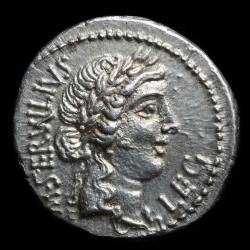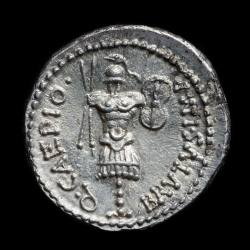This denarius was struck by a mobile military mint moving with Brutus and his army in the months leading up to the Battle of Philippi (October 42 BC). Sear has suggested that it may have been produced at Sardis on the occasion of the second meeting of Brutus with Cassius, his co-conspirator in the assassination of Iulius Caesar on 15 March 44 BC. Although this meeting was marred by mutual suspicion, the two men ultimately agreed to join their forces and together march west against the Second Triumvirate.
The obverse type features the laureate head of Libertas, the Roman personification of liberty and freedom. The type refers to the role of Brutus in the murder of Caesar and in freeing (for a short time) the Roman people from the threat of the return of hated monarchy to their city. Brutus and his associates frequently invoked Libertas on their coinages and habitually described themselves as the Liberatores.
The trophy on the reverse serves to advertise the recent victories of Brutus, accompanied by his legate M. Servilius, while campaigning in Lycia. Brutus had demanded money and soldiers from the cities of the Lycian League to bolster his forces for the looming confrontation with the armies of the Second Triumvirate, but when they were not forthcoming he plundered the capital at Xanthus and other Lycian cities, reportedly making himself ”tremendously rich”. The silver used to strike this denarius may very well have been carried off from Lycia by Brutus’ forces.

